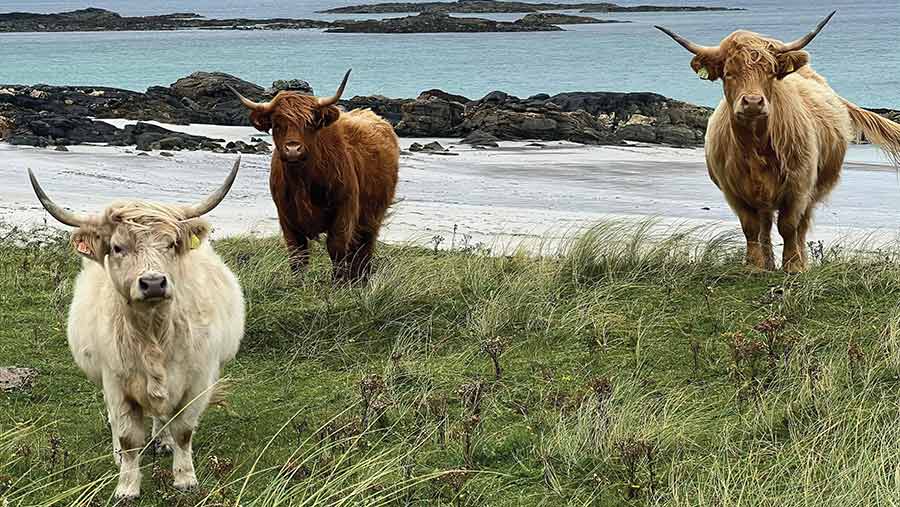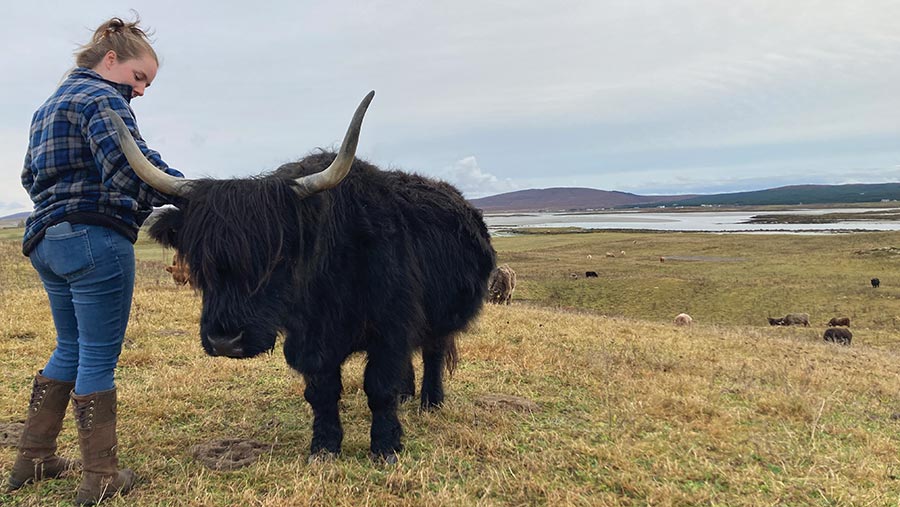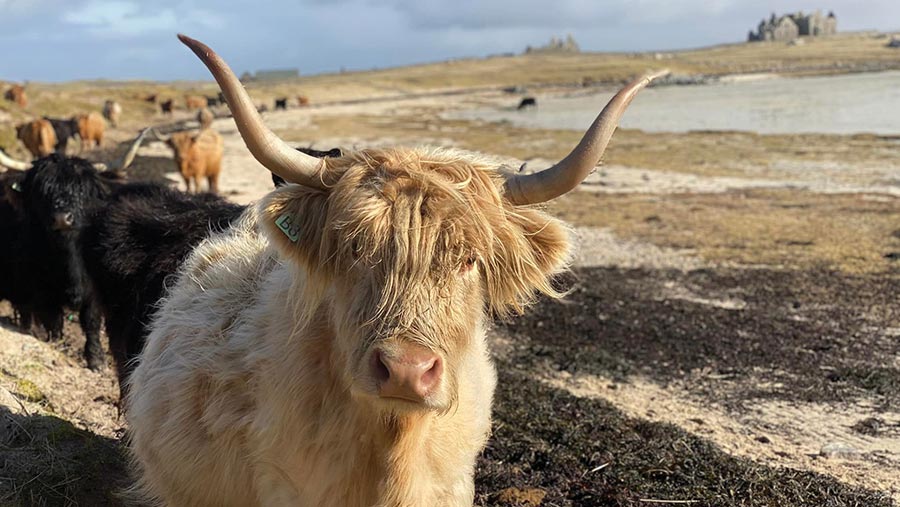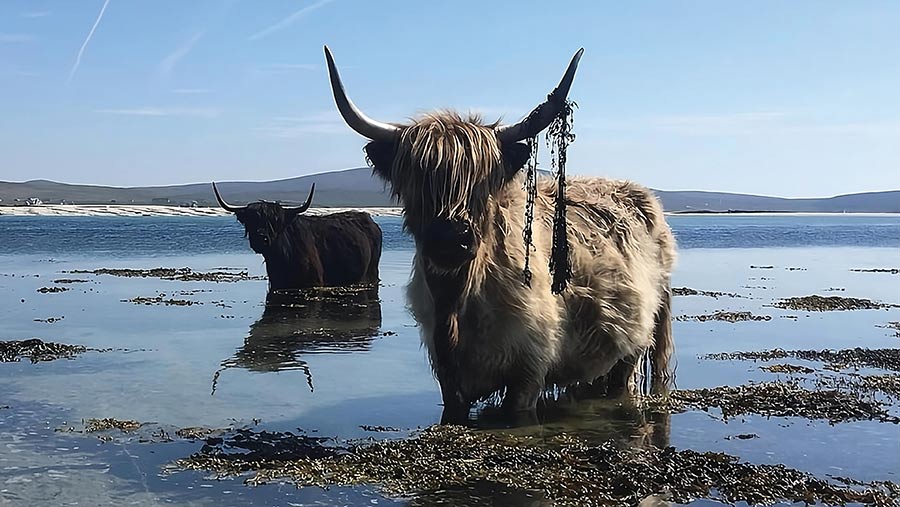Video: How a hardy herd successfully outwinters in Outer Hebrides
 © Ardbhan Highland Cattle
© Ardbhan Highland Cattle Hardy, maternal genetics are ensuring a Scottish family can trust their cows to successfully winter and calve unaided on an island, only being checked on during low tide.
The Ardbhan fold of Highland cattle has been bred to be functional and correct by the MacDonalds of Kyles, North Uist.
See also: Why a high-index Lleyn breeder sold flock to get into sucklers
They have grazed their cattle on Vallay – a tidal island off the north-west coast of Uist – since 1998. They acquired the island – and some ground on mainland Uist – in 2011.
First it was used as expansive summering ground, but now it is their winter home, reached by walking across 1.8 miles of sand at low tide.
Farm facts: Ardbhan Fold
- 149 Highland females bulled this year
- Using Beef and Whitebred Shorthorn bulls to breed store cattle
- Extensive pedigree sales
- 607ha of improved ground, of which 56ha grows arable
- 1,214ha of heather hill (3,000 acres)
- 300 commercial breeding ewes – Scottish Blackface, Scotch Mule and Texel cross
Labour requirements

Carianne MacDonald © MAG/Michael Priestley
Angus MacDonald registered the Ardbhan fold in 1985, starting with six breeding cows.
Alongside wife Michelle and children Fraser, Alexander and Sarah and daughter-in-law Carianne, the MacDonalds run a diverse business.
Carianne is the day-to-day farmer, doing stockwork and feeding the cattle and sheep. All family members help on big sorting days.
Carianne’s winter routine involves driving 1.8 miles across the bay at low tide for regular cattle checks.
Typically, this is a six-hour window of opportunity. A drive through a fresh water lochan (pond) cleans the pick-up of salt water and sand on the way home.
Hear more on how the MacDonalds have been working hard to improve the island’s agricultural use and value over the years in the video below.
Native cattle
Many cows live to be 18-20 years of age, producing 15 calves or more, and never see the inside of a shed.
The cattle are suited to the climate. Some lines go back to the 1800s and some to the Balranald fold, which dates to the 14th century.
Vallay has a 120ha (297-acre) calving field, which is fenced to save time on checking stock. This field has plenty of sand dunes and other sheltered areas on the leeward side of the prevailing westerly wind.
The MacDonalds do not have a calving jack. Angus recalls a 14-year period with no assisted calvings.
Over the past nine years there have been six assisted calvings, which were mostly breech births.
Strict breeding goals

© Ardbhan Highland Cattle
Vallay is about 10 miles (20min) away from the steading, so the cows must calve unassisted.
A stock trailer is kept on the island at calving but is often not required. Carianne has had to deal with some issues, but losses are as low as one calf every couple of years.
Angus and Fraser have focused closely on the following traits to ensure functional cattle for a breeding premium:
- Good feet structure Hooves are never trimmed. Good pasterns are essential for cows to graze and thrive, milking well and maintaining condition to rebreed.
- Sound udder and moderate teat size A zero-tolerance policy towards large teats means all calves can access and suck from birth. Udders stay functional until cows are older than 20 years
- Breed type A strong Highland type ensures pedigree demand for genetics. All colours (red, yellow, brindle, dun, white and black) are bred for. Genetics have gone as far as Estonia, Germany, Romania, and Spain
- Fertility Barren rates are 10-15%, but this has improved by 10% over the past 12 or so years and bulling periods have fallen from 12-14 weeks to 10-11 weeks. The MacDonalds hope to continue making gains in this area by selectively culling empty cows and have started calving heifers at two years.
Wider business and contracting
- Agricultural contractor
- Employs more than 20 people, including 14 full-time staff
- Cut peat for 300 customers
- Civil engineering projects have included airport sea defence, school football pitch and many residential houses
- A fish waste processing plant that will produce biodiesel (from fish oil) and a fishmeal fertiliser should commence in 2024
Organic improvements

© Ardbhan Highland Cattle
Angus has spent his farming career improving land and striving to progress. For example, in 1998, he ordered one of the first two combine harvesters on Uist.
Despite having his hands tied somewhat by farming organically, Angus has used shoreline seaweed to add fertility and minerals to the sandy, coastal “machair” land.
He also uses seaweed to improve the soil on a large area of flat land in the centre of the island, where he grows crops of arable silage for the cows’ winter diet.
The fertiliser process is as follows:
- December Mature kelp is harvested with a telehandler on the beach at low tide and rotted down in piles.
- February Composted kelp is spread on the land at 100t/ha to nourish the soil with nitrogen and minerals. This is applied with an Agrihire 16t rear-discharge dung spreader.
- April Kelp is then disc-harrowed into the soil and arable silage crops are planted.
- Post-planting A thin layer of fresh kelp seaweed is added by the same dung spreader to protect seedlings, helping germination and crop nutrition and preventing wind erosion and goose damage.
Infrastructure
The first fencing was done to divide the island into thirds in 2000. Before that it was one extensive piece of ground, which made checking and gathering stock difficult.
There is now a holding pen and handling area in the middle of the island and 14 fields, each watered by freshwater ponds and springs.
Solar-powered energisers are used to electrify wires to stop cattle breaking fences. Barbed wire does little to stop Highland cattle due to their long hair and tough skin, explains Angus.
Outwintering
Cows are on Vallay for most of the year, heading back to the mainland for June through to October.
The sandy “machair” land means they have a dry lie all winter, but they benefit from the mainland’s mineral rich heather and moorland water in summer.
Calving runs from late March to early June in eight bulling groups that are given 10-11 weeks with the bull.
An Ardbhan cow weighs 450-500kg and is budgeted to eat 12 bales of forage from early January until the end of calving.
The MacDonalds make 2,000-2,500 bales a year for the sheep and cattle, with 200-300 usually left over.
Grass silage is made at home and 1,000 bales are hauled to Vallay for wintering, costed at £20 a bale (no fertiliser).
The arable silage grown is a mix of of rye, oats and barley. The seeds are native and broadcast as they are too big for a conventional drill.
Each year some seeds are combined and stored for the following year.
Through the winter, cattle are fed 60 bales of silage weekly, spread out across the island as much as possible.
Bales are stood on their end and cut. No ring feeders are used.
If geese are pecking and excreting on bales, 30 bales are put out twice a week to minimise contamination.
